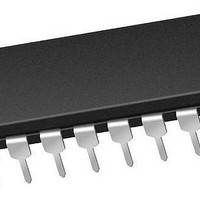PIC16F1829-E/P Microchip Technology, PIC16F1829-E/P Datasheet - Page 257

PIC16F1829-E/P
Manufacturer Part Number
PIC16F1829-E/P
Description
14 KB Flash, 1K Bytes RAM, 32 MHz Int. Osc, 18 I/0, Enhanced Mid Range Core 20 P
Manufacturer
Microchip Technology
Series
PIC® XLP™ mTouch™ 16Fr
Datasheet
1.PIC16LF1829-ISO.pdf
(420 pages)
Specifications of PIC16F1829-E/P
Core Processor
PIC
Core Size
8-Bit
Speed
32MHz
Connectivity
I²C, LIN, SPI, UART/USART
Peripherals
Brown-out Detect/Reset, POR, PWM, WDT
Number Of I /o
17
Program Memory Size
14KB (8K x 14)
Program Memory Type
FLASH
Eeprom Size
256 x 8
Ram Size
1K x 8
Voltage - Supply (vcc/vdd)
1.8 V ~ 5.5 V
Data Converters
A/D 12x10b
Oscillator Type
Internal
Operating Temperature
-40°C ~ 125°C
Package / Case
*
Processor Series
PIC16F182x
Core
PIC
Data Bus Width
8 bit
Data Ram Size
1 KB
Interface Type
I2C, SPI, USART
Maximum Clock Frequency
32 MHz
Number Of Programmable I/os
18
Number Of Timers
5
Operating Supply Voltage
1.8 V to 5.5 V
Maximum Operating Temperature
+ 125 C
Mounting Style
Through Hole
Lead Free Status / RoHS Status
Lead free / RoHS Compliant
Lead Free Status / RoHS Status
Lead free / RoHS Compliant
- Current page: 257 of 420
- Download datasheet (5Mb)
25.4.5
The I
transition of SDAx from a high to a low state while
SCLx line is high. A Start condition is always gener-
ated by the master and signifies the transition of the
bus from an Idle to an Active state.
shows wave forms for Start and Stop conditions.
A bus collision can occur on a Start condition if the
module samples the SDAx line low before asserting it
low. This does not conform to the I
states no bus collision can occur on a Start.
25.4.6
A Stop condition is a transition of the SDAx line from
low-to-high state while the SCLx line is high.
FIGURE 25-12:
FIGURE 25-13:
2010 Microchip Technology Inc.
Note: At least one SCLx low time must appear
2
C specification defines a Start condition as a
START CONDITION
STOP CONDITION
before a Stop is valid, therefore, if the SDAx
line goes low then high again while the SCLx
line stays high, only the Start condition is
detected.
SDAx
SCLx
I
I
2
2
C START AND STOP CONDITIONS
C RESTART CONDITION
Condition
Start
S
2
C Specification that
Data Allowed
Data Allowed
Figure 25-10
Change of
Change of
Preliminary
Condition
Restart
Sr
25.4.7
A Restart is valid any time that a Stop would be valid.
A master can issue a Restart if it wishes to hold the
bus after terminating the current transfer. A Restart
has the same effect on the slave that a Start would,
resetting all slave logic and preparing it to clock in an
address. The master may want to address the same or
another slave.
In 10-bit Addressing Slave mode a Restart is required
for the master to clock data out of the addressed
slave. Once a slave has been fully addressed, match-
ing both high and low address bytes, the master can
issue a Restart and the high address byte with the
R/W bit set. The slave logic will then hold the clock
and prepare to clock out data.
After a full match with R/W clear in 10-bit mode, a prior
match flag is set and maintained. Until a Stop condi-
tion, a high address with R/W clear, or high address
match fails.
25.4.8
The SCIE and PCIE bits of the SSPxCON3 register
can enable the generation of an interrupt in Slave
modes that do not typically support this function. Slave
modes where interrupt on Start and Stop detect are
already enabled, these bits will have no effect.
PIC16F/LF1825/1829
Data Allowed
Change of
Data Allowed
RESTART CONDITION
START/STOP CONDITION INTERRUPT
MASKING
Change of
Condition
Stop
P
DS41440A-page 259
Related parts for PIC16F1829-E/P
Image
Part Number
Description
Manufacturer
Datasheet
Request
R

Part Number:
Description:
IC, 8BIT MCU, PIC16F, 32MHZ, SOIC-18
Manufacturer:
Microchip Technology
Datasheet:

Part Number:
Description:
IC, 8BIT MCU, PIC16F, 32MHZ, SSOP-20
Manufacturer:
Microchip Technology
Datasheet:

Part Number:
Description:
IC, 8BIT MCU, PIC16F, 32MHZ, DIP-18
Manufacturer:
Microchip Technology
Datasheet:

Part Number:
Description:
IC, 8BIT MCU, PIC16F, 32MHZ, QFN-28
Manufacturer:
Microchip Technology
Datasheet:

Part Number:
Description:
IC, 8BIT MCU, PIC16F, 32MHZ, QFN-28
Manufacturer:
Microchip Technology
Datasheet:

Part Number:
Description:
IC, 8BIT MCU, PIC16F, 32MHZ, QFN-28
Manufacturer:
Microchip Technology
Datasheet:

Part Number:
Description:
IC, 8BIT MCU, PIC16F, 32MHZ, SSOP-20
Manufacturer:
Microchip Technology
Datasheet:

Part Number:
Description:
IC, 8BIT MCU, PIC16F, 20MHZ, DIP-40
Manufacturer:
Microchip Technology
Datasheet:

Part Number:
Description:
IC, 8BIT MCU, PIC16F, 32MHZ, QFN-28
Manufacturer:
Microchip Technology
Datasheet:

Part Number:
Description:
IC, 8BIT MCU, PIC16F, 20MHZ, MQFP-44
Manufacturer:
Microchip Technology
Datasheet:

Part Number:
Description:
IC, 8BIT MCU, PIC16F, 20MHZ, QFN-20
Manufacturer:
Microchip Technology
Datasheet:

Part Number:
Description:
IC, 8BIT MCU, PIC16F, 32MHZ, QFN-28
Manufacturer:
Microchip Technology
Datasheet:

Part Number:
Description:
MCU 14KB FLASH 768B RAM 64-TQFP
Manufacturer:
Microchip Technology
Datasheet:

Part Number:
Description:
7 KB Flash, 384 Bytes RAM, 32 MHz Int. Osc, 16 I/0, Enhanced Mid Range Core, Low
Manufacturer:
Microchip Technology

Part Number:
Description:
14KB Flash, 512B RAM, 256B EEPROM, LCD, 1.8-5.5V 40 UQFN 5x5x0.5mm TUBE
Manufacturer:
Microchip Technology
Datasheet:










